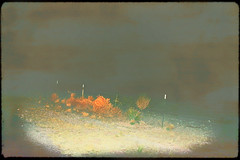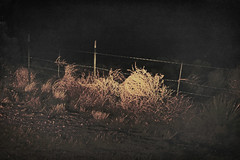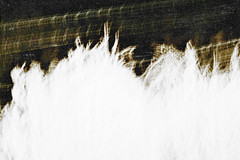The Art - Photography
North of the Trinity Atomic Bomb Site
2008
North of the Trinity Atomic Bomb Test Site, New Mexico. 2008. Processed 2022.
These very processed photos come of my at least wanting to acknowledge passing near the Trinity site but not visiting it--and I know I'll never visit it because it's only open twice a year and as our lives have ever stood we don't have the means and ways to be that specific in time and dedication of funds to view where The Bomb was born. On our speedy pass through New Mexico in 2008, we reached the road to Trinity, off US 380, long after dark and our originally projected arrival time. This access to Trinity is 5 miles north of the Stallion Range Gate through which we would have needed to pass, and then travel 17 miles to the site itself, on one of the two days a year when it's open.
I don't know why it's only open two days a year.
"It's out there," I told a young Aaron, my son, then about ten years of age, pointing out into the dark, and took several bad photos of tumbleweed piled up against the fence next the entry road. For some reason I didn't take a photo of the plaque that tells you where you are. The tumbleweeds spoke to me more.
Because of growing up near Hanford, and thus my interest in The Bomb due Hanford's part in the Manhattan Project and the area's subsequent problems with radioactive waste, I had wanted, that time out through New Mexico, to make a point of at least passing by the Trinity Atomic Bomb Test Site. It had meaning for me then, as from 2005 to 2007 I had been doing art based on photos I'd pulled from the Hanford Declassified Document Retrieval System. In preparation for doing the art, and because it was near impossible to perform meaningful searches in the HDDRS, its accessibility seeming to be configured to make it as difficult to as possible to make specific searches (almost non-existent tags) or randomly explore, and as at that time very few photos had been culled from it and posted onto the internet for easy viewing, I spent months searching for interesting photos that depicted Hanford workers and their living situation from WWII and put them on Flickr with full attribution. Occasionally I'd return and pull more, posting about 950 images over the years before the government suddenly took down the HDDRS. The database eventually came back online but seems even more difficult than before, and search terms I once used now give zero returns.
This area of New Mexico smelled like Richland/Hanford, and parts looked almost exactly like the desert outside Richland/Hanford. There was the pile of familiar tumbleweeds piled up outside the fence and that's what spoke to me most. My childhood was filled with tumbleweed. So I took photos of those.
Having lived near Hanford when I was growing up, I feel that I know a little of what Lynch was trying to communicate about this area in Twin Peaks: The Return and wrote a little about it in my analysis. Growing up in the shadows of the Manhattan Project and its radioactive waste, what was unleashed on the world, you look out into the desert and you sense and smell what it was "before", that's there, the illusion of what it once was, the wilderness, but you also know how illusory that is and that the before is nothing like the after.






